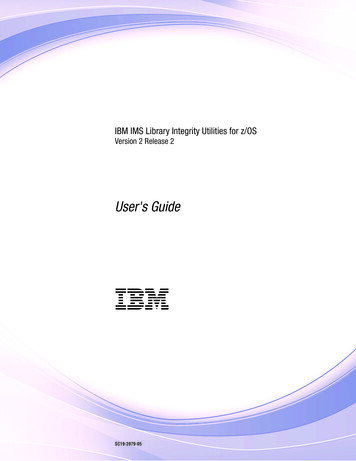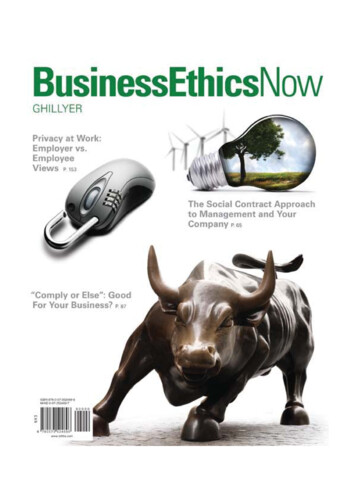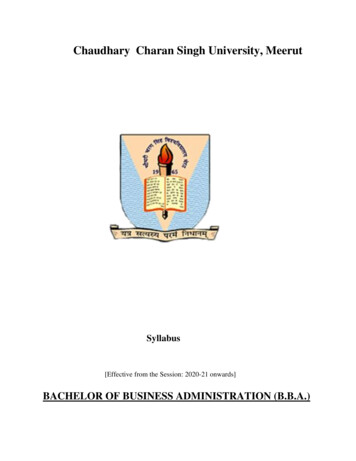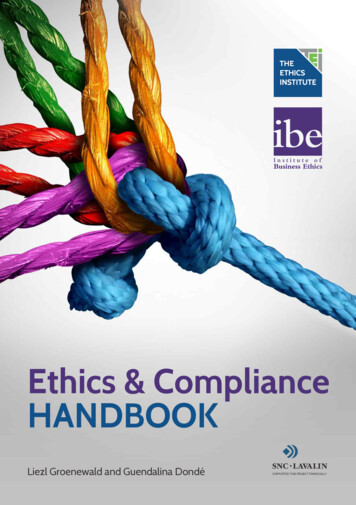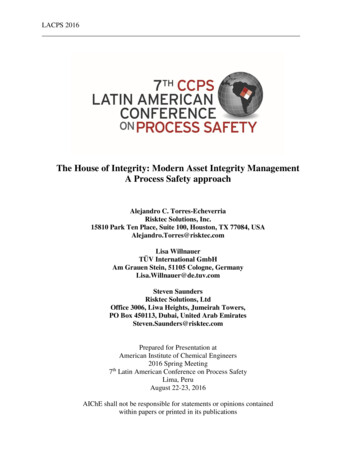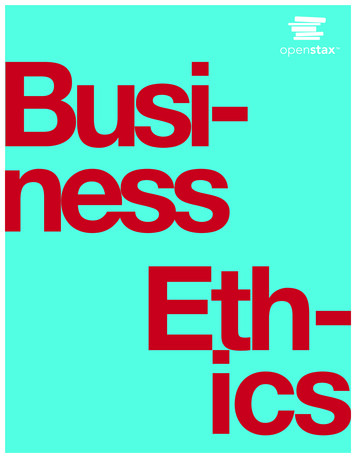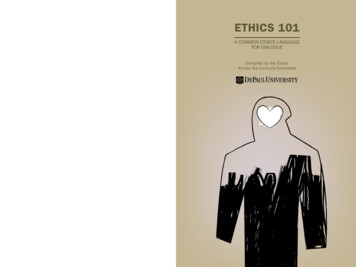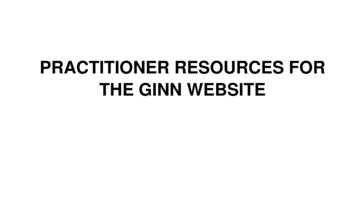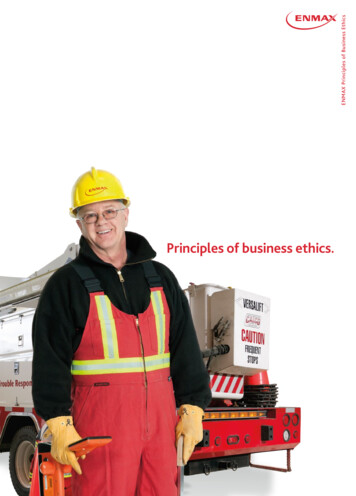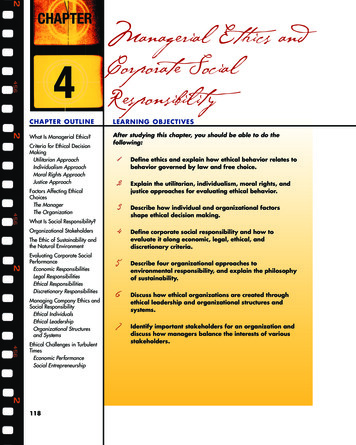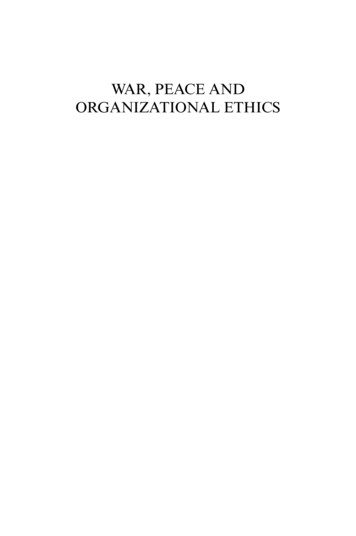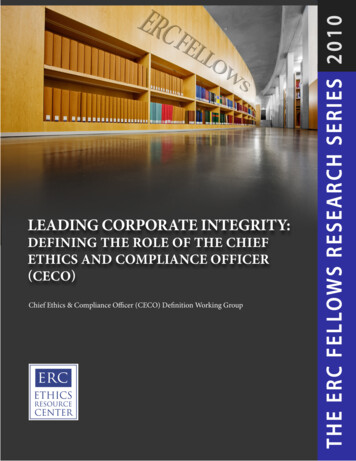
Transcription
Leading Corporate Integrity:Defining the Role of the ChiefEthics and Compliance Officer(CECO)Chief Ethics & Compliance Officer (CECO) Definition Working Group
CECOWorking Group Co-Chairs:Scott A. Roney, Vice President,Compliance & EthicsArcher Daniels Midland CompanyERC FellowPatricia J. Harned, Ph.D., PresidentEthics Resource CenterParticipating Nonprofit Executives:Business Roundtable Institute for Corporate EthicsDean Krehmeyer, Executive DirectorEthics and Compliance Officer Association (ECOA)Keith T. Darcy, Executive DirectorEthics Resource Center (ERC)Patricia J. Harned, Ph.D., PresidentOpen Compliance and Ethics Group (OCEG)Scott Mitchell, Chairman & CEOSociety of Corporate Compliance & Ethics (SCCE)Roy Snell, Executive DirectorEthics Resource Center Fellows:Barbara Hannigan, Ethics Officer & Senior Compliance Counsel, The Public Company AccountingOversight Board (PCAOB), & ERC Fellows Non-profit and Government Vice-ChairNancy Heebsh,Manager, Business Integrity, Marathon Oil CompanyW.Michael Hoffman, Ph.D., Executive Director, Bentley College Center for Business EthicsJeff Oak, VP, Corporate Responsibility Officer, Bon Secours Health System, Inc.Caitlin O’Brien, Director, Compliance & Business Integrity, Veterans Health AdministrationAbout the Authors:Special thanks to Dean Krehmeyer (Business Roundtable Institute for Corporate Ethics), Joe Murphy (SCCE), andPatricia Harned (ERC) for their contribution of sections to this document.We are also grateful to Kelly Ray (OCEG)for her additions and edits. Overall editing was provided by Patricia Harned and ERC staff members Eric Call, PaulaDesio, Nick Fetzer, and Jaclyn Kupcha.
FOREWORDThe need for this paper was perhaps best evidenced by a headline appearing onForbes.com on October 23,2006, questioning “Chief Ethics Officers: Who Needs Them?” 1 The article was a response to statistics thathad been reported just a few days earlier by Business Week that during the first three quarters of 2006, aCEO was fired every thirteen days as the result of scandal. 2 “Chief ethics and compliance officers havebecome trendy in recent years,” the Forbes article went on to say, “but some experts fear they act mainlyas window dressing.”Yet research suggests that when appropriately designed and situated in an organization, ethicsprograms—and the officers who lead them—can and do make a difference. 3 The key is to have a programthat is adequately structured, with sufficient authority and responsibility given to its designated leader tocarry out his or her responsibilities. When this happens, a proper tone is set from the top, an ethicalculture grows, and misconduct is reduced. By contrast, a Chief Ethics and Compliance Officer (CECO)who serves as window dressing likely does more harm than good, especially in times of difficulty.A close look at ethics and compliance programs across companies suggests that there is widedisagreement about the best way to situate a CECO. Conversations with CECOs also quickly reveal theirfrustration: these professionals cannot fully do their jobs. Their issue is not the desire to perform; rather,despite good intentions on the part of their employers, many CECOs are set up for failure due to deficientresources, inadequate preparation, or insufficient authority.The purpose of this paper therefore is to suggest the role that is most appropriate to the corporate CECOsuch that an organizational ethics and compliance capability can achieve its intended purpose. Thedocument that follows is a product of the Ethics Resource Center’s Fellows Program, and is also theresult of several discussions among leaders of some of the most prominent nonprofit organizations in theethics and compliance industry, convened to speak with onevoice on this issue.Our intention with this document is to offer suggestions, but not to prescribe detailed solutions. Everyorganization is unique; therefore the way a CECO functions must also be tailored to the corporateenvironment in which that person operates. What is universal is the fact that ethics is essential tolongstanding success in business and the recovery of public trust in market economies. If ethics is to be apriority, it must be championed and fully supported. To that end, we offer this report as a starting placefor a continuing discussion of the most effective ways to enable CECOs and their organizations to achievesuccess.Scott A. RoneyCo-Chair, CECO Working GroupPatricia J. HarnedCo-Chair, CECO Working Group1Clark, Hannah. (2006, October 23). Chief Ethics Officers: Who Needs 10/23/leadershipethics-hp-lead-governcx hc 1023ethics.html2LaVelle, Louis. (2006, October 12). CEOs Feel the oct2006/db20061012 398172.htm?campaign id rss daily3Ethics Resource Center (2005). National Business Ethics Survey, Washington, DC: ERC.
EXECUTIVE SUMMARYSenior corporate executives are under great pressure to build and maintain strong organizational ethicsprograms. The stakes are high for any organization that fails to make ethics a priority and then finds itselfembroiled in scandal.Public perceptions—often driven by the media—spoil a company’s reputation and weaken its brandvalue. Lowered trust among investors can devastate a company’s ability to attract support for growth.Regulators and lawmakers may move swiftly to punish and/or further regulate those who step outsideaccepted ethical boundaries.Today, many organizations are choosing to consolidate the critical responsibility for ethics andcompliance programs under a chief ethics and compliance officer (CECO). But the specific roles andreporting lines for this relative newcomer among corporate management positions are not always clearlydefined; many CECOs report feeling set up for failure due to insufficient authority or inadequateresources.This paper is intended to serve as the starting point for a dialogue within corporate management circles—particularly among CEOs, boards of directors and the CECOs themselves—about the proper placement,qualifications, and responsibilities for a leader of the corporate ethics and compliance function.This paper also provides resources and identifies additional steps for further examination of this criticalmanagement function. The Bottom Line: CECOs Add Value CECOs whose roles are clearly andproperly defined and who are empowered to create and maintain strong ethics programs: Help provide shelter from severe sanctions in the event of legal/regulatorydifficulty; Contribute to the establishment of an enduring ethical culture; Help other corporate leaders prevent misconduct or effectively address itwhen it occurs; and Provide a public demonstration of the organization’s commitment tointegrity.To truly be a value-added function, the CECO must have a well-defined role and be endowed withadequate resources. This demands a balance between tailoring the job to an organization’s uniquecharacteristics and providing the CECO with the basic authority and tools that should be universal for allwho hold such positions.At minimum, a CECO should be: Held accountable to the governing authority to carry out the board’sdelegated fiduciary responsibilities;
Independent to raise matters of concern without fear of reprisal or a conflictof interest; Connected to company operations in order to build an ethical culture thatadvances the overall objectives of the business; and Given the authority to have decisions and recommendations taken seriouslyat all levels of the organization.The CECO also must have the financial and human resources necessary to comprehensively promotestandards, educate the workforce, and respond to potential violations in a timely manner.A CECO’s line of reporting is perhaps the single biggest influence on his or her credibility and authoritywithin the organization. Ideally, the CECO will: Have employment decided and terminated only at the direction of the boardof directors; Directly report to either the board or the CEO; Have direct, unfiltered access to the board; and Achieve performance goals as defined by the board and CEO.The CECO position should be augmented by the board’s appointment of one independent director ormember of the audit committee, knowledgeable about business ethics and compliance, with accountabilityfor ethics and compliance.A CECO should be a full member of executive leadership, expected to: Oversee assessmentnoncompliance; Establish organizational objectives for ethics and compliance; Manage the organization’s entire ethics and compliance program; Implement initiatives to foster an ethical culture throughout the organization; Supervise ethicsorganization; Frequently inform the board of directors and senior management team ofrisks, incidents, initiatives driven by the ethics and compliance program, andprogress toward program goals; Implement a program of measurement to monitor program performance; edmisconductthroughoutandthe
Oversee periodic measurements of program effectiveness.Sample position descriptions and case studies of CECOs are available on the Ethics Resource Centerwebsite.4Like any other member of the senior executive team, a CECO should enter the position with certainknowledge and skills, including: Management experience; Ability to work at the executive level; Knowledge of business; Knowledge of and passion for ethical conduct and compliance; and Strong personal character and a commitment to integrity.Beyond their daily duties, CECOs have a responsibility to themselves and to the broader ethics andcompliance field. As executives, CECOs should consider themselves accountable to a standard of conductequal to that imposed upon other executives and the board, as well as the broader public and to CECOpeers.As a result, CECOs must: Demand a high standard of conduct from vendors, non-governmentalorganizations (NGOs), and others providing ethics and compliance relatedservices; Take responsibility for the preparation of rising CECOs and other ethics andcompliance professionals; and Advance knowledge and shape public dialogue about ethics and compliance.Infusing and maintaining the highest ethical standards across the extended enterprise are among the mostimportant job responsibilities in corporations today. The role of the CECO has emerged in response to thedemand for a more accountable, transparent, and ethical business culture, and the creation of CECOpositions across industries is testimony to corporate leaders’ recognition of the importance of ethics andcompliance in assuring their companies’ success and longevity.Still, many executives and boards have not yet realized the potential of their CECOs, in some cases by not4For additional resources related to this paper, please visit www.ethics.org/CECO.
providing adequate resources or authority to those holding the position. This report further defines theCECO role and demonstrates its critical value to an organization.Properly constituted, the CECO investment is always worthwhile—because, in the end, ethical conduct isa key ingredient in building and sustaining investor and stakeholder trust and in protecting society fromorganizational misconduct.
INTRODUCTION―Our financial markets have been widely regarded as the fairest, most transparent,and most efficient in the world. But now it’s becoming increasingly clear thatsomething has gone wrong—seriously wrong.We are facing a crisis of confidencethat is eroding the public’s trust in our markets, and poses a real threat to oureconomic health.‖–Senator Paul S. Sarbanes (D-MD)5On July 30, 2002, just 11 days after Senator Sarbanes addressed the House-Senate Conference on whatwas then called the Public Company Accounting and Investor Protection Act of 2002, the mostcomprehensive effort to regulate American corporations since the Securities and Exchange Act of 1934 6was signed into law.Corporate life was substantially changed. There was very little question at the time that efforts wereneeded to increase the attention given by business leaders to the ethics and compliance of theirorganizations. Despite a time of intense political polarization, both chambers of Congress were united asthey passed the Sarbanes-Oxley Act (SOX) with overwhelming support: no dissenting votes in the Senateand only three dissenting votes in the House. Congress clearly agreed with President Bush’s statementthat “the business pages of American newspapers should not read like a scandal sheet.” 7 The SOX Actwas intended to establish “significantly higher standards for corporate responsibility and governance.” 8And so it did.In a “post-SOX era,” such matters as prevention and detection of criminal conduct, effectiveness ofinternal controls, independence of auditors and directors, and disclosures in financial reporting have allbecome daily challenges to corporations. Compliance now involves not only obedience to the laws thatare directly related to conducting an organization’s actual business, but also adherence to many otherstandards designed to regulate the internal operations of the business itself. In some cases, compliance isbecoming an organizational department as well as a line item in company budgets.Yet SOX was just one influence in a series of legislative and regulatory efforts to systematically initiatethese sweeping reforms. A myriad of external authorities have now added expectations to whichcorporations must also respond. Revisions to the Federal Sentencing Guidelines for Organizations(FSGO), new listing requirements by exchanges, Internal Controls and Enterprise Risk AssessmentGuidelines, governance standards, and new accounting rules subsequent to SOX have also contributed tes, Breena E. (2002). Rogue Corporations, Corporate Rogues & Ethics Compliance: The Sarbanes Oxley Act,2002. d States. Congress. (2002). Senator Sarbanes, 148 Cong. Rec. S7350-04.
the new environment in which businesses presently operate. While these laws, standards and guidelinesare designed to enhance protection of corporate stakeholders, they also create new challenges forcorporations and potentially detract from the overall goal of corporate integrity.With attempts to mandate appropriate behavior, greater focus has been spent in the last two years oncompliance than ethics. 9 Meanwhile research increasingly reveals that, in terms of actual impact, theseprogrammatic efforts pale in comparison to the creation and perpetuation of a culture that emphasizesintegrity and leadership from the top down and that holds the organization and its stakeholdersaccountable to high ethical standards.10With every new rule and every new insight, the tasks involved with leadingcorporate efforts in compliance and fostering a corporate culture of integrityare only becoming more complex and demanding.Where do these increasingresponsibilities fall within an organization?In 1991, the original FSGO suggested that organizations designate a “high-level position” to help overseethe compliance function of an organization, in order to address what were already heightened concernsthat organizations needed to prevent and respond to misconduct. Because the specifics of this FSGOpolicy were left open to interpretation, ensuing practices varied widely. In some cases, the CEO was theself-proclaimed “ethics officer.” In many other cases, however, another individual was appointed to takeon the responsibility; this person, however, was often degrees removed from the CEO and/or the board ofdirectors. Until recently, the role of the ethics or compliance officer was simply encompassed within theresponsibility of human resources, legal, finance, or audit. Increasingly, the position is now gaining thetitle of “chief” ethics officer and/or “chief” compliance officer and is sometimes coupled with vicepresidential, executive vice presidential, or an even higher executive level position. 119Open Compliance and Ethics Group (2007). OCEG Governance, Risk & Compliance Strategy Study, Phoenix,AZ: OCEG.1011Ethics Resource Center (2005). National Business Ethics Survey, Washington, DC: ERC.www.zoominfo.com now reflects 39 listings with the title “Ethics Officer” or “Chief Ethics Officer” (with over50% of those identified as a vice president or higher level position) and over 1,200 listings with the title “ChiefCompliance Officer” but with a much smaller percentage including a vice president or higher level positiondesignation.More than 800 job titles exist in the ethics and compliance function (Murphy, J. & Leet, J.(2006).Working for Integrity, 63-88). Therefore, many organizations do not have an individual with the specific titleof CECO. In this paper, we use the title CECO intending to address the individual with overall responsibility for theethics and/or compliance function.
Today, best practice suggests that the role of a “designated high-level official” has come even fartherfrom its original conception, in many ways due to SOX and other regulatory policies which have assignedculpability for missteps in ethics and compliance to the board of directors and senior leaders. The job isnow far more than a CEO, CFO, or CLO can reasonably fulfill without assistance. The responsibilities ofthe chief ethics and compliance officer (CECO)—as a key player in protecting the organization’sgoverning authorities—are now immense, ranging from training the board of directors to oversight of aninternal audit of the compliance function itself.The knowledge, skills, and experience needed to fulfill the duties of the CECO far surpass previousexpectations.12 Where ethics and compliance was once a silo within an organization, today theresponsibility extends from the board down and across to functions of ethics, compliance, legal, finance,internal audit, human resources, and risk management. External auditors are as much a part of the pictureas internal employees, taking a new interest in compliance largely under the rubric of their assessment ofentity level controls. The scope of the function extends beyond employees in the U.S. to workers globally.And so today, the job description for a CECO has a breadth more like that of a CEO than a direct (andsometimes indirect) report:12Salary.com and Ethics Officer Association Survey Validates Value of Ethics and ComplianceOfficers’ Roles in Today’s Corporate World
13Responsibility for the conduct of employees worldwide and oversight of global programs as they relate toall initiatives of the company are no small tasks.The stakes are high for every organization. Despite strides made through regulation and otherprogrammatic efforts, research indicates that one in two employees still observe what they believe to be atleast one act of misconduct each year, 14 and the penalties are more severe for organizations that have nottaken adequate steps to prevent and detect such behavior. Expectations of voluntary disclosure oftransgressions to authorities and cooperation in government investigations are also heightened.As the responsibilities of ethics and compliance grow, more questions arise as to the specific authorityneeded and the best possible role for effective oversight.For example: What is the role of a designated CECO, and what kind of authority should heor she be given? Who is the best possible CECO in an organization—the CEO, generalcounsel, or some other designee? If not the CEO, to whom should a CECO report? What is the appropriate involvement of the board in the ethics andcompliance program and what should be the relationship between the boardand the CECO? What does it mean to put adequate resources into the ethics and compliancefunction?1515 What skills and qualifications are needed to competently perform the job of aCECO?13Identity of the organization listing the position has been withheld.14Ethics Resource Center (2005). National Business Ethics Survey, Washington, DC: ERC.15(2005). Federal Sentencing Guidelines. www.ussc.gov/2005guid/8b2 1.htm. USSC, §8B2.1(b)(2)(C).
What are the responsibilities of this individual (or individuals) to theorganization and to the ethics and compliance profession?The purpose of this paper is to closely examine these and other issues surrounding the designation ofleadership responsibility for the corporate ethics and compliance function. Specifically, it is the intentionof the authors of this document to examine the role of the CECO, the placement of such an individual,and the authority that will enable his or her oversight most effectively.This research was undertaken in response to a need that has been repeatedly articulated by CECOs inforums hosted by some of the leading associations in the ethics and compliance field. The need forclarification of the role also arose in a meeting of the Ethics Resource Center Fellows Program,16 whichled to the creation of a CECO Definition Working Group to address the concerns.Recognizing that the impact of the issues extended far beyond the ERC Fellows and that there was a needfor broad collaboration, the working group was soon expanded to include executive directors andpresidents of five of the leading nonprofit organizations serving ethics and compliance officersthroughout the country. As such, the CECO Definition Working Group also includes the BusinessRoundtable Institute for Corporate Ethics, the Ethics and Compliance Officer Association (ECOA), theOpen Compliance and Ethics Group (OCEG), and The Society of Corporate Compliance and Ethics(SCCE).Together the working group created an outline for this document, which was then presented at two ECOAconferences for feedback from ethics and compliance practitioners. This paper was subsequently authoredby the executive directors and selected designees of all five organizations comprising the working groupand has been reviewed by members and stakeholders of each organization.Our goal has been not only to consider and address the issues surrounding the role of the CECO, but alsoto represent the collective experience and recommendations of our constituents, with their wealth ofknowledge concerning ethics and compliance in action and experience applying the concepts in their ownorganizations.The document that follows this introduction is organized into five sections. To begin, the valueproposition of the ethics and compliance function and its CECO are addressed in Section I.Next, in Section II, the ideal role of the CECO is discussed. Specific focus is given to the integration ofthis role in the senior level decision-making and strategy setting processes. This section also expounds themeaning of the FSGO requirements regarding high level personnel and the assignment of day-to-dayoperational responsibility for a program.Section III addresses the skills and qualifications necessary for effective practice of the CECO job16The Ethics Resource Center (ERC) Fellows Program is a forum for senior level practitioners, scholars andnonprofit leaders to identify emerging issues and conduct research in corporate compliance and ethics.
function. Advancements in certification, professional educational programs and business school curriculaare also discussed here.The responsibilities of the CECO to governing authorities and the profession at large are introduced inSection IV.In the Conclusion and Next Steps, summary remarks offer suggestions of next steps for a) boards ofdirectors; b) CEOs; c) CECOs; and d) professional organizations, consultants, and vendors in the ethicsand compliance field. Additional questions to be considered in future research are also posed.This working group hopes that, in suggesting steps to be taken by organizationsto adequately staff their ethics and compliance needs, we will spur our readersto initiate dialogue in their organizations.Every organization is unique, and therefore the means by which it articulates and addresses itsexpectations for corporate integrity will vary. CECOs, in many ways, are a reflection of the corporateculture in which they operate. Nevertheless, the need for guidance throughout the corporate world isclear: “If corporate leaders are serious about ethics, they will have to empower their ethics officials todevelop tough programs that challenge and monitor senior executives at a level of intensity commensuratewith the power that they wield.”17It is our further intention that this document and the ensuing dialogue will make strides in challengingsenior leaders to consider the ways in which they can best empower their CECOs. Finally, we endeavor tospeak to current ethics and compliance officers themselves, in order to encourage improvement ofpractice, offer courage in challenging their organizations, and promote overall advancement of theprofession as a whole.17Terris, Daniel. (2005,March 20). How To Teach Ethics to 20.html.
SECTION I:Chief Ethics and Compliance Officers—The Value PropositionWhy do companies have ethics and compliance officers, and more specifically why should they have aCECO? In most parts of the world it is not technically a legal requirement, nor has it reached the level ofprevailing practice such that the majority of organizations have a CECO (or the equivalent). 18 In the U.S.,however, it is becoming increasingly rare for any large company not to have a CECO, and smallercompanies are also gradually creating the position. Yet common practice does not necessarily mean thatcompanies are adopting the best possible practice. Are corporations better off because they have a CECO?18The answer is yes. One can make a legal, business, and philosophical case that CECOs add value to acorporation.One of the most significant benefits for organizations with CECOs (and theprograms they create) is the shelter that such high-level ethics officers canprovide in the event of trouble.Most of the credit for this contribution rests with the Federal Sentencing Guidelines for Organizations(FSGO), promulgated by the U.S. Sentencing Commission in 1991. The Guidelines provide thatcompanies sentenced for most federal crimes must receive a reduction in fines if they meet certainstandards, including having an effective ethics and compliance program with a high-level person orpersons given responsibility for the function. 19Similarly, federal government enforcement officials have adopted the approach and the standards of theGuidelines in making enforcement decisions. Instead of a company being indicted, tried, convicted andsentenced, enforcement authorities may consider the effectiveness of the existence vel non of acompliance program as a factor in determining whether to indict a lawbreaking corporation, as illustratedin both the 2003 Thompson and 2006 McNulty memoranda issued by the U.S. Department of Justice. 20Other federal regulations and enforcement authorities have taken a similar approach. 21Continuing case law is enhancing the value proposition of the CECO in running an effective program thatprotects the organization and its board from liability. A landmark corporate law case in the ChanceryCourt in Delaware, the Caremark case, indicated that board members could face potential personal18There are exceptions where a Compliance & Ethics officer may be required, as discussed later in this section.19www.ussc.gov/2005guid/8b2 1.htm. USSC, §8B2.1(b)(2)(C) and 8C2.5(f).20U.S. Department of Justice (2003). Principles of Federal Prosecution of Business Organizations. See alsowww.usdoj.gov/dag/speech/2006/mcnulty memo.pdf.21For a review of some of these practices, see Report of the Ad Hoc Advisory Group on the OrganizationalSentencing Guidelines (2003, October 7), p.32-35. www.ussc.gov/corp/advgrprpt/ag final.pdf.
liability if they failed to ensure that appropriate information and reporting systems were instituted bymanagement. 22 The U.S. Supreme Court, in cases dealing with harassment and discrimination, has heldthat compliance efforts should be taken into account in determining liability and punitive damages. 23 Noris this message limited to the United States. For example, companies in Italy may defend against chargesof corrupt practices based on the existence of a compliance program. 24Note, however, that none of these governmental policies technically mandate that companies havecomprehensive programs or CECOs—companies can opt not to create creditworthy programs and crosstheir fingers that they will never have to face the government in an actual investigation or enforcementproceeding. This situation changes dramatically if a company does run afoul of the law. Companies mayhope to avoid indictment or negotiate settlement agreements, which can bear a number of differentnames; 25 however, these agreements generally require that companies institute compliance programsunder government oversight as a condition of probation. 26 Depending on the level of detail, agenciesinstituting these agreements will typically require high-level oversight in the form of a CECO. Theseagreements range across a variety of industries and address numerous offenses, 27 although in someindustries, such as healthcare, the agreements are more detailed.Perhaps the ultimate legal case for the value of a CECO is being made by incremental governmental stepsto go beyond incentives and negotiations and fully mandate that companies have programs, includingethics and compliance officers. The first initiatives on the path of mandating ethics and complianceprograms have been to require specific steps like harassment training (a few states now require this),helplines, codes of conduct and internal controls for publicly traded companies in the U.S. (SOX). Thereare also examples where compliance programs are required in specific risk areas: HIPAA requires privacycompliance programs in U.S. healthcare; Germany requires companies to have privacy complianceofficers;
The CECO also must have the financial and human resources necessary to comprehensively promote standards, educate the workforce, and respond to potential violations in a timely manner. A CECO's line of reporting is perhaps the single biggest influence on his or her credibility and authority within the organization. Ideally, the CECO will:
